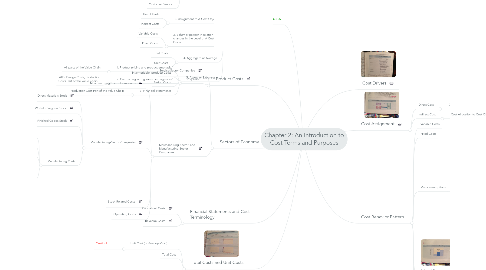
1. Total Costs and Unit Costs
1.1. Unit Cost (or Average Cost)
1.1.1. Caution!
1.2. Total Cost
2. Financial Statements and Cost Terminology
2.1. Capitalised Costs
2.2. Revenue Costs
3. Sectors of Economy
3.1. Service-Sector Companies
3.2. Merchandising-Sector- and Manufacturing-Sector Companies
3.2.1. Merchandising-Sector Companies
3.2.2. Manufacturing-Sector Companies
3.2.2.1. Direct Materials Stock
3.2.2.2. Work-In-Progress Stock
3.2.2.3. Finished Goods Stock
3.2.2.4. Manufacturing Costs
3.2.2.4.1. Direct Material Costs
3.2.2.4.2. Direct Manufacturing Labour Costs
3.2.2.4.3. Indirect Manufacturing Costs
3.2.2.4.4. Manufacturing Cost System
3.2.3. Stock-Related Costs
3.2.4. Operating Costs
4. Product Costs
4.1. Purposes
4.1.1. '1. Product pricing and product emphasis.'
4.1.1.1. All parts of the Value Chain
4.1.2. '2. Contracting with government agencies'
4.1.2.1. R&D, Design Costs, Production Costs Part of the Value Chain
4.1.3. '3. Financial Statements'
4.1.3.1. Production Cost Part of the Value Chain
5. Classification of Costs
5.1. 1. Business Function
5.1.1. Research and Development
5.1.2. Design of Products, Services and Processes
5.1.3. Production
5.1.4. Marketing
5.1.5. Distribution
5.1.6. Customer Service
5.2. 2. Assignment to A Cost Object
5.2.1. Direct Costs
5.2.2. Indirect Costs
5.3. 3. Behavior pattern in relation to changes in the Level of A Cost Driver
5.3.1. Variable Costs
5.3.2. Fixed Costs
5.4. 4. Aggregate or Average
5.4.1. Total Costs
5.4.2. Unit Costs
5.5. 5. Assets or Expenses
5.5.1. Inventoriable (product) Costs
5.5.2. Period Costs
6. Cost Assignment
6.1. Direct Cost
6.1.1. Cost Tracing to Cost Object
6.2. Indirect Cost
6.2.1. Cost Allocation to Cost Object
7. Cost Drivers
8. Cost Behavior Pattern
8.1. Variable Costs
8.2. Fixed Costs
8.3. Major assumptions
8.3.1. '1. Costs are defined as variable or fixed with respect to a specific cost object.'
8.3.2. '2. The time span must be specified. Consider the 20€ million rent and insurance Renault pays for its Sandero plant. This amount may be fixed for one year. Beyond that time, the rent and insurance may be renegotiated to be, say, €22 million for a subsequent year.'
8.3.3. '3. Total costs are linear. That is, when plotted on ordinary graph paper, a total variable-cost or a total-foixed-cost relationship to the cost driver will apear as anunroken straight line.'
8.3.4. '4. There is only one cost driver. The influences of other possible cost drivers on total costs are held constant or deemed to be insignificant.'
8.3.5. '5. Variations in the level of the cost driver are within a relevant range (which we discuss in the next section).'
8.4. Relevant Range
8.5. Relationships of types of costs
8.5.1. Direct and Variable
8.5.2. Direct and Fixed
8.5.3. Indirect and Variable
8.5.4. Indirect and Fixed
